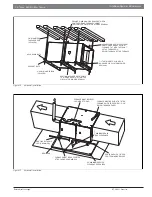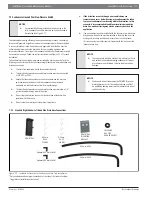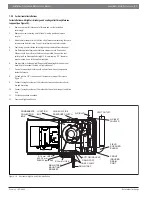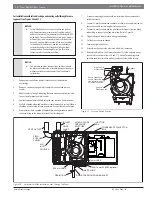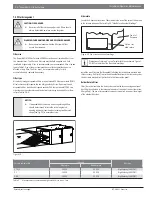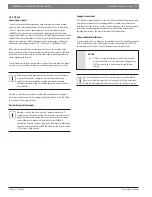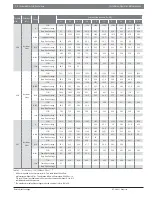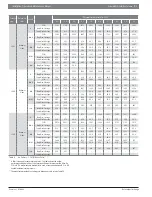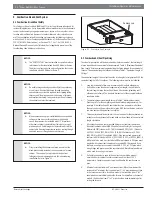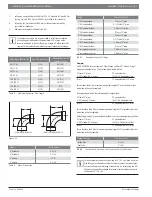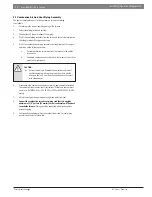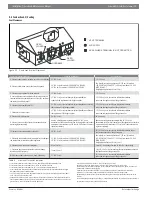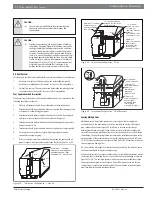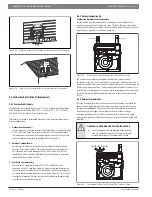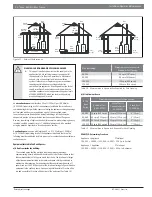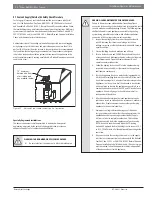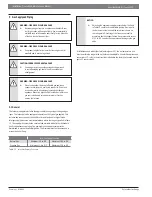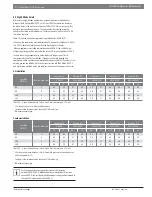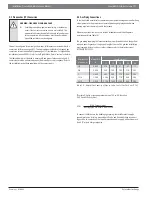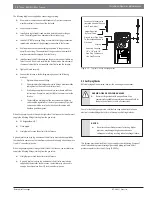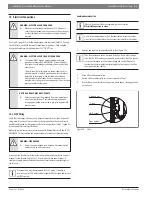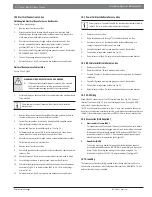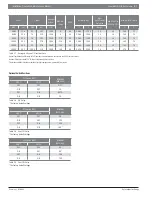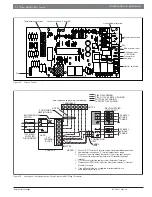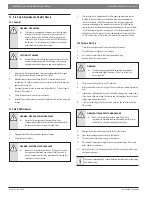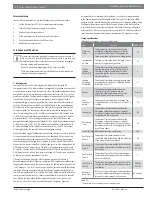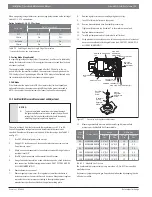
3 0 |
E
coer
96%
A
F
UE
Gas Furnace
Installation, Operation & Maintenance
07-2021
|
E
coer
I
nc
.
Data subject to change
CAUTION:
The vent must be installed with the minimum required
clearances, and must comply with local codes and
requirements.
CAUTION:
Consideration must be given for degradation of building
materials by flue gases. Sidewall termination may require
sealing or shielding of building surfaces with a corrosion
resistant material to protect against combustion product
corrosion. Consideration must be given to wind direction
in ord er to prevent
fl
ue products and/or condensate from
being blown against the building surfaces. If a metal shield
is used it must be a stainless steel material at a minimum
dimension of 20 inches (51 cm). It is recommended that
a retaining type collar be used that is attached to the
building surface to prevent movement of the vent pipe.
8.5 Vent System
This furnace is certi
fi
ed to be installed with one of two possible vent con
fi
gurations.
1.
Horizontal vent system. This vent system can be installed completely
horizontal or combinations of horizontal, vertical, or offset using elbows.
2.
Vertical vent system. This vent system can be installed completely vertical
or a combination of hori zontal, vertical, or offset using elbows.
Vent Applications And Termination
When selecting the location for a horizontal combustion air / vent termination, the
following should be considered:
1.
Observe all clearances listed in vent clearances in these instructions.
2.
Termination should be positioned where vent vapors will not damage plants
or shrubs or air conditioning equipment.
3.
Termination should be located where it will not be affected by wind gusts,
light snow, airborne leaves or allow recirculation of
fl
ue gases.
4.
Termination should be located where it will not be damaged or exposed to
fl
ying stones, balls, etc.
5.
Termination should be positioned where vent vapors are not objectionable.
6.
Horizontal portions of the vent system must slope upwards and be
supported to prevent sagging.
7.
Direct vent systems must be installed so the vent and the combustion air
pipes terminate in the same atmospheric zone. Refer to Figures 25 or 26.
Figure 24
12” Min.
12” Min.
Exhaust
Exhaust
Maintain 12” minimum
clearance
above highest
anticipated snow level.
Maximum 24” above roof.
Termination Con
fi
guration - 1 Pipe, No
Figure 25
Maintain 12” minimum
clearance above
highest anticipated
snow level.
12” vertical separation
between combustion air
intake and vent.
12” minimum
below overhang
12” minimum
separation between
bottom of
combustion air pipe
and bottom of vent.
Maintain 12”
minimum clearance
above highest
anticipated snow
level or grade,
whichever is higher.
Air Intake
Exhaust
Exhaust
Air Intake
Termination Con
fi
guration - 2 Pipe
Figure 26
12” MIN.
12” MIN.
G
N
A
H
R
E
V
O
12” Minimum
below overhang
12” Minimum
separation between
bottom of
combustion air
intake and
bottom of vent
Maintain 12”
minimumclearance
above highest
anticipated snow
level or grade,
whichever is higher
Air Intake
Exhaust
Air Intake
Exhaust
Termination Con
fi
guration - 2 Pipe Basement
Venting Multiple Units
Multiple units can be installed in a space or structure as either a single pipe
con
fi
guration or a two-pipe con
fi
guration. The combustion air side of the single
pipe con
fi
guration shown in Figure 24 is referred to in these instructions as
ambient combustion air supply. Follow the instructions for ambient combustion
air installations, paying particular attention to the section on air source from inside
the building. The vent for a single pipe system must be installed as speci
fi
ed in the
venting section of these instructions with the vent terminating as shown in Figure
24. Each furnace must have a separate vent pipe. Under NO circumstances can the
two vent pipes be tied together.
If air from outside is brought in for combustion and ventilation, the con
fi
ned space
shall be provided with two permanent openings.
Follow the instructions for outdoor combustion air or ventilated combustion air and
the instructions for installing the vent system with the vent terminating as shown in
Figures 27 or 28. The two-pipe system must have a separate combustion air pipe
and a separate vent pipe for each furnace. Under NO circumstances can the two
combustion air or vent pipes be tied together. The combustion air and vent pipes
must terminate in the same atmospheric zone.

